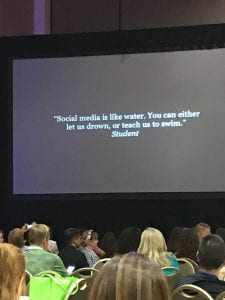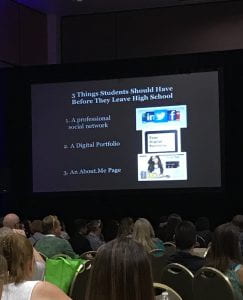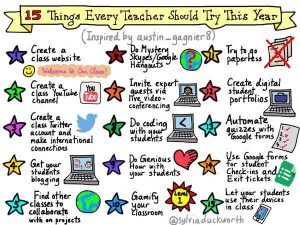Back to school: 15 things to try out this school year
Autism Cheat Sheet for Educators
I am a Digital Citizen
The Top 4 Excuses For Not Being a Connected Educator
Humorous tongue in cheek article to inspire the reluctant “non-connected educator” to get plugged in:
October is Dyslexia Awareness Month
Here’s a listing of events happening all over the country in honor of Dyslexia Awareness Month. Help spread awareness and support for those with dyslexia by participating and promoting these events!
5 Ways Technology Has Impacted Education
The following list of articles provide insight on some of the ways technology impacts today’s educational landscape. Topics include: challenges educators face incorporating digital tools; class to class Skyping; equity and inclusion in the digital age; characteristics of 21st century learning; and, epistemic games.
Educational Technology – tried and true ed tech tools to use in your classroom or at home
Having utilized a variety of Ed Tech tools and apps the past few years, I have gathered a list of my favorites (thus far) to share with all of you. Check out some of my favorites and try them out for yourself. If you find some I have not listed, do let me know and I will check them out and add them to my Edshelf list.
UDL – Universal Design for Learning
I am sure you have all heard of brain-based learning. Universal Design for Learning is essentially designed to help teachers tap into brain-based learning and find ways to differentiate instruction to maximize learning for as many students as possible at once.
Click on the following link to find out more about how UDL will help enhance learning for your student/child.
The Common Core State Standards and the Special Educator
With the transition to the Common Core State Standards, there is much anxiety on the part of teachers parents alike about what they really mean. Here are some links to several video presentations that will hopefully clarify what the CCSS are and why we are shifting to these new academic content standards.
The following are links to sites that explain the common core in layman terms:
A new school year, a look ahead…
As a teacher or parents, what are your major concerns for your student with learning difficulties as the new school year approaches?
Common Learning Difficulties: What they look like and how you can help.
A.D.D/A.D.H.D.
What does it look like?
- Fails to give close attention to details or makes careless mistakes
- Has difficulty sustaining attention in tasks or even play activities
- May have poorly formed letters or words or messy handwriting
- Does not follow through with instructions – fails to complete schoolwork or chores
- Avoids tasks that requires sustained mental effort
- Forgetful in daily activities
- Loses things necessary for tasks (books, pencils, assignments)
- Has difficulties organizing tasks and activities
Hyperactivity type:
- Acts as if “driven by a motor” and cannot remain still
- Blurts out answers to questions before the question has been completed, often interrupts other
How to help?
- Where possible, allow student to change work sites frequently while completing a task or studying or take movement breaks (ESPECIALLY A.D.H.D. KIDS – i.e., let them run a lap)
- Assign jobs that involves movement – passing out papers, running errands
- Vary tone of voice, loud, soft, whisper, to sustain attention
- Employ multi-sensory strategies when instructions are given – visual (write on board), auditory (read it aloud)
- Divide assignments into smaller chunks with frequent breaks
- Have student verbalize a plan for completing the task or solving a problem before attempting it
- Permit student to do something with hands during sustained listening – stress ball, clay, paper folding
- Work out an inconspicuous cue to signal the student when he/she tunes out
DYSLEXIA
What does it look like?
- Reads slowly and painfully
- Has decoding errors, especially with the order of letters
- Shows wide disparity between listening comprehension and reading comprehension of text
- Has trouble with spelling
- May have difficulty with handwriting
- Has difficulty with recalling known words
- Decodes real words better than nonsense words
- Substitute one small sight words for another: a, I, he, the, there, was, on, in
- Has difficulty with written language
- May even have trouble with math computations
How to help?
- Provide a quiet place for activities like reading
- Use books on tape
- Use books with large print and big spaces between lines
- Allow alternative forms for book reports
- Provide study guides and lecture notes
- Test for knowledge – don’t count spelling on history, science or other such tests
- Allow the use of word processing tools
- Use logic rather than rote memory in teaching
- Present materials in small units/chunks
VISUAL PERCEPTUAL/VISUAL MOTOR DEFICITS
What Does It Look Like?
- May have reversals: b for d, p for q, or inversions: u for n, w for m
- Has difficulty finding his/her way around campus
- Complains eyes hurt and itch, rubs eyes, complains print blurs while reading
- Turns head when reading across page or holds paper at odd angles
- Closes one eye while working, yawns a lot while reading
- Cannot copy accurately
- Loses place frequently
- Does not recognize word if part of it is shown
- Holds pencil too tightly/frequently breaks pencil point/crayons
- Struggles to cut or paste
- Messy papers – letters misaligning, colliding, irregular spacing, letters not on line
How To Help?
- Avoid grading handwriting
- Allow students to dictate creative stories
- Experiment with different paper types, pastels, graphs, embossed raised line paper (now available at Office Depot)
- Provide tracking tools: rulers, text windows
- Use large print books where possible
- Provide alternatives for written assignments or a scribe
- Suggest use of pencil grips and specially designed pencils or pens
C.A.P.D. (Central Auditory Processing Disorder)
What Does It Look Like?
- Has trouble processing and remembering language-related tasks, but may not have trouble with environmental sounds, music
- May process thoughts and ideas slowly and has difficulty expressing/explaining them
- Misspells/mispronounces similar-sounding words or omits syllables; confuses similar-sounding words (celery/salary, three/free)
- Often distracted by background sounds – can’t tune them out
- Have student constantly verbalize concepts, vocabulary words, rules, etc
- Has difficulty staying focused on or remembering verbal presentations
- Has difficulty with complex sentences
- Says “What?” a lot, even when he/she has heard much of what is said
How To Help?
- Show rather than explain
- Teach to other senses – use visual cues, signals, handouts, manipulatives
- Avoid asking student to listen and write at the same time
- Vary pitch of voice, alter pace, stress key words
- Ask questions as you teach to check for understanding
- Allow for thinking time (5-6 seconds) when questioning
- Have student constantly verbalize concepts, vocabulary words, rules, etc
- Reword or help students decipher oral and/or written directions
Need special ed. information?
Need information about services for your child?
How do I support my son or daughter at home?
Do we REALLY need to get help?
Feel free to post a query and I will do my best to share what I know or help you find the answers.
Cheers!
Celine O’Hara
Special Ed. Teacher/Educational Therapist







